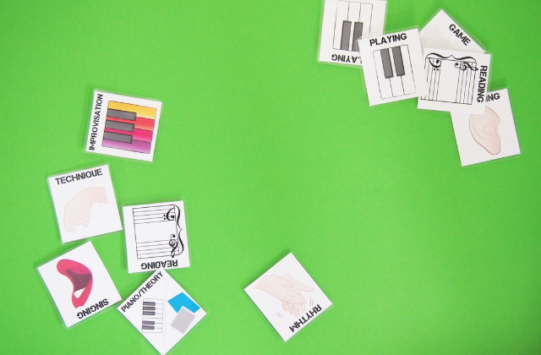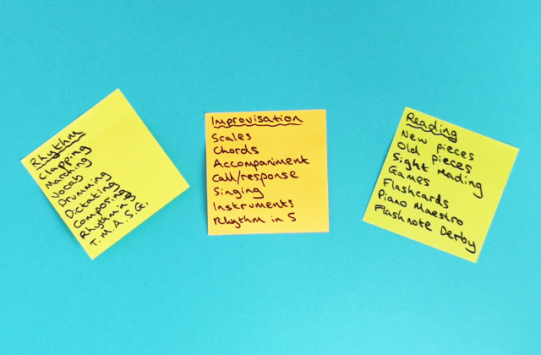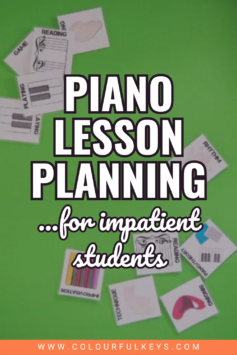
This blog post about piano lesson timing was written by Juanita Stauffer. Juanita teaches out of her home studio to a variety of students. She enjoys finding new music and new activities to do with students, and hopes to include even more creative activities in her lessons. When not teaching piano, she enjoys knitting, gardening, reading and playing the cello.
All music studio teachers have heard it before: “How much time do we have left?” And it’s not just the student who asks! As a teacher, I’m always juggling what must be covered before the lesson clock runs out.

I have a big wall clock in my piano studio. It’s behind the piano so students have to turn around to see it. There are some who manage a quick look pretty much every week, and others who hardly ever check. In fact, some students even ask at the end of their lesson, “Are we done already?”
I imagine you can identify. But what’s a teacher to do when the inevitable question – “When will the lesson be over?” – comes up?
The Student: “How much time is left?”
Often when piano students ask how much time is left, they simply want to know. They’re learning how to manage their own time, and getting used to how long an activity takes. Sometimes a student might just be very excited about a special event immediately following their lesson. Other times, they ask because they can’t read the analogue clock on the wall. 🤪
When I sense something like this is why they’re asking, I simply tell them, and then we move on.
Lesson Structure
But sometimes the question reveals a deeper issue. There’s a good chance that if piano students are regularly asking this question, I need to re-think the structure and timing of the lesson.
Some students, especially the very young ones and some with special needs, find it tricky to grasp the concept of time. Having a visual “map” of the lesson can provide them with a bit of security, so they understand what’s coming and don’t have to worry about surprises.
Some teachers use cards that show the various elements of a lesson (e.g. reading pieces, sightreading, technique and games). Either the teacher or the student chooses the order of activities at the beginning of the lesson.
Try these Visual Lesson Plan Cards, exclusively from the Vibrant Music Teaching Printable Library. Glue magnets, clothes pegs or velcro on the back, and you’ve got a great way to move the cards around and help your piano students see the timing of the lesson.

Not a member of VMT? You’re missing out on so much! Learn more and join today at vibrantmusicteaching.com.
Using a system like this helps a student track where they are in a lesson, so they’ll have no need to ask about the time.
Off-Bench Activities
Like the old adage says, “Time flies when you’re having fun”. If students are bored, they’re bound to keep their eyes glued to the clock. So be sure your lessons are filled with fun!
Including games, movement and brain breaks can make the time go more quickly for the active (and even the not-so-active) students while, at the same time, making learning more efficient and effective.
Need help planning your lessons? Nicola has just what you need at her Planning Lessons hub page.
The Teacher: “How much time is left??!!”
It’s not just students who keep their eyes on the clock. As a teacher, do you continually scramble to fit everything in? Are you left with 4 or 5 minutes at the end of each lesson wondering what you’ve missed?
Lesson Plan Mishaps
After teaching for many years, I usually have a pretty good sense of how to pace the timing of a piano lesson. This can involve speeding up an activity or slowing it down, or even skipping a particular element for that week.
Still, every now and then, my guess is wrong. Maybe a technical element takes much longer than usual, or a piece that was just assigned last week needs extra attention.
And then there’s that pie-in-the-sky situation when a student comes to lessons having perfected a piece when you weren’t expecting it. Suddenly you need something new to assign!
In any of these cases, I’m left scrambling for time and trying to get through the rest of the material we need to do in record-quick time.
I also have a bad habit of trying to fit too much in. Maybe a student hasn’t practised everything simply because I gave them way too much to work on in a single week. Or maybe I overestimated their ability to learn a particular piece.
Either way, we use precious lesson minutes to close that gap, and we run out of time before I can cover new material.
When my lesson plan goes awry, I need to step back and analyse where I went wrong and try to adjust for the following week. In some cases, I’ll even ask the student for input – they tend to have a pretty good idea of what they can work on, especially if it’s a long-time student of mine.
Lesson Priorities
I’ve learnt that, if I want an activity to happen, I pretty much have to schedule it at the beginning of the lesson. Otherwise I end up reverting to old habits (like just flipping the page) which don’t give my students the full creative lesson experience.
For example:
- When I know that my beginner student will be learning a new concept or technique in the upcoming piece, it’s extremely helpful to introduce it in a game format or physical activity at the beginning of the lesson before encountering it on the page.
- If a student is preparing for a performance, doing a little rehearsal first thing in a lesson ensures this important preparation gets done.
- If a student is determined to finish a particular studio challenge, I want to give them the opportunity to finish that before running out of time that day.

On the whole, I’ve found if we want to accomplish specific goals, we must address them early in the lesson schedule.
Bonus Time
Once in a while, I’ll get through everything on the lesson plan and the clock shows a few minutes left.
With younger students, it’s quick and easy to add a game or activity to reinforce the things they’ve been working on. But teen students can be a little more picky about what they like to do in a lesson and how much they want to practise at home.
Regardless, it’s important to be aware of how the piano lesson is proceeding and how the pacing or timing is working. If I realise that we have 20 minutes left in the lesson and only 10 minutes of planned work left, I can go more in-depth on a particular issue whereas, at another time, I might not have the luxury to do so.
Keep a few things in your back pocket for each skill level to use as bonus activities when that beautiful “extra time” situation arises:
- Improvisation is great to fill any amount of time
- With Reading Railroad, you can knockout sight reading in just 2 or 3 minutes.
- When was the last time you did any ear training? Fill 90 seconds with some solfa singing activities.
For older students, technology can fill those smaller gaps of 2 – 3 minutes quite well with apps like Note Rush and Tenuto.
If you need to fill a few minutes at the end of a lesson, why not try a micro-composition prompt? Nicola and her team will send you a level 1 minibook for free when you enter your info below.

Subscribe to the newsletter and get the Micro-Composition Level 1 Minibook
Enter your details to subscribe to the newsletter for piano teachers with information, tips and offers.
I hate spam as much as you do! I will only send you emails related directly to piano teaching and you can unsubscribe at any time.
Members of Vibrant Music Teaching can download 3 levels of micro-composition minibooks from the VMT Library (for beginners – early intermediates). Not a member? What are you waiting for? Learn more and join today at vibrantmusicteaching.com.

What do you do with the question, “How much time is left?”
I’d love to hear more ideas of what else to fit into a lesson when you have extra time with older students.